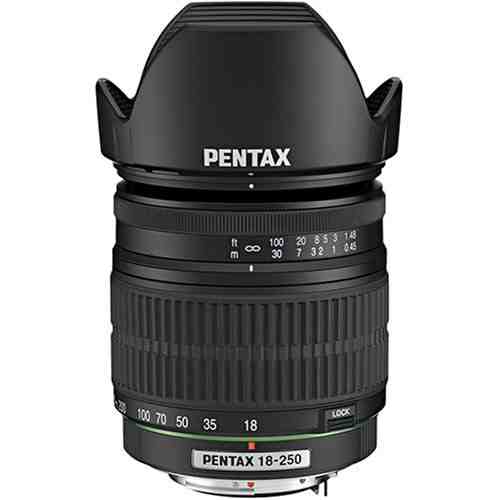Pentax SMC DA 18-250mm f/3.5-6.3
 |
| Gary Wolstenholme takes a look at this all purpose superzoom for use on Pentax digital SLR cameras that covers a range equivalent to 27 – 375mm on a 35mm camera. |
Pentax's 18-250mm superzoom costs around £500 and is ideal for the photographer who wishes to travel light, but still requires a large focal range. It is the only lens of this type in their line-up adding an extra 50mm to the usual 18-200mm normally found on marque superzooms.
Third party manufacturers have long dominated the superzoom market, and both Sigma and Tamron make lenses with equivalent specification. Tamron's 18-250mm costs around £380 and looks uncannily similar to the Pentax optic in terms of size. Sigma's 18-250mm OS HSM costs around £400 but adds optical stabilisation you can see working through the viewfinder and a silent focusing motor.
Pentax SMC DA 18-250mm f/3.5-6.3: Handling and features
This lens appears to be reasonably well built, with the barrel being constructed from high quality plastics. The zoom mechanism is nice and smooth and the lens extends in two sections, more than doubling in size at maximum extension. A petal shaped hood is supplied with the lens which clips into the bayonet fitting around the 62mm filter thread. I had no issue with swift zoom creep during use as the zoom system has just enough resistance to make it stay put.
Focus is performed internally and unfortunately isn't all that quick, sometimes hunting for a second or two at the long end of the zoom range. This lens also lacks the full time manual focus feature found on so many other Pentax lenses. As the maximum aperture is only f/6.3 at the long end, the viewfinder image can appear quite dull, especially when not shooting in the brightest conditions, which may make manual focusing difficult anyway. As the focusing is internal the filter thread does not rotate, making this lens perfect for use with polarising filters.
Pentax SMC DA 18-250mm f/3.5-6.3: Performance
Constructing a lens with such a huge zoom range involves all sorts of compromises. Unfortunately as far as resolution is concerned these compromises lead to reduced performance. At 18mm and the maximum aperture the sharpness can only really be described as disappointing, being fair in the centre and slightly less than fair towards the edges. Stopping down does improve matters, but the aperture needs to be closed down a fair way before the resolution starts to exceed good levels here. Peak quality is achieved at f/16 where sharpness is very good in the centre and good towards the edges.
Matters improve somewhat when the lens is zoomed to 70mm. Here the resolution is approaching good levels at maximum aperture and peak quality across the frame is achieved at f/11, where the sharpness in the centre approaches excellent levels and the quality is good towards the edges.
Finally at 250mm the performance at f/6.3 returns to slightly disappointing levels. As this lens will spend most of its time at maximum aperture in auto mode, this is where the performance is most critical. Here the sharpness in the centre is fair and will probably satisfy those wishing to make 6x4inch prints of their holiday snaps just fine. Stopping the lens down improves matters and peak quality across the frame is achieved at f/11 where sharpness in the centre is very good.
Chromatic aberrations are well controlled for a lens of this type, with colour fringing staying well below acceptable levels throughout the zoom range. Fringing across the frame reaches levels that may pose a problem in very large prints at 250mm and f/6.3.
Falloff of illumination towards the edges of the frame is kept to reasonable levels. At 18mm and f/3.5 the corners are 1.43 stops darker than the image centre and visually uniform illumination is achieved at f/5.6. Vignetting is reduced slightly at 250mm with the corners only being 1.16 stops darker than the image centre. Again, f/8 results in visually uniform illumination here.
Distortion is surprisingly well controlled for a lens of this type with Imatest recording a level of 3.36% barrelling at 18mm. Although this amount of distortion will be noticeable in images with straight lines, it is much less than I expected from this optic. Again at 250mm there is a surprisingly low level of distortion. Here Imatest recorded only 0.248% pincushioning, which can be quite difficult to see. The distortion pattern throughout the range is uniform, so should be easy to correct in software afterwards if needed.
Flare can be an issue when shooting into the light, resulting in a distinct loss of contrast and flare patterns that may dominate your image. A petal shaped lens hood comes supplied with the lens normally, but unfortunately it was missing from the sample provided for review. Still, I'd recommend leaving it in place all the time as light sources outside of the frame can also result in loss of contrast and beautiful, yet dominant flare patterns.
 | DxOMark provides objective, independent, RAW-based image quality performance data for lenses and digital cameras to help you select the best equipment to meet your photographic needs. Visit the DxOMark website for tests performed on the Pentax SMC DA 18-250mm f/3.5-6.3. |
Pentax SMC DA 18-250mm f/3.5-6.3: Verdict
As I mentioned earlier, lenses with huge zoom ranges like this often result in compromise of some sort. It seems unfortunate in this case that the aspect of performance to lose out is sharpness at maximum aperture, which is how I believe a lens like this will be used most of the time.
Still, the quality is good enough to satisfy those after postcard size prints for their holidays with the minimum of fuss, so I suppose you could argue that Pentax did their market research when designing this lens. Whether a lens like this will be worth £500 to you will be entirely subjective. I know I'd rather spend my money elsewhere.
Pentax SMC DA 18-250mm f/3.5-6.3: Pros
 Low distortion for a superzoom
Low distortion for a superzoom Low CA levels
Low CA levels Impressive zoom range
Impressive zoom rangePentax SMC DA 18-250mm f/3.5-6.3: Cons
 Disappointing resolution at maximum aperture
Disappointing resolution at maximum aperture Slow AF
Slow AF Susceptible to flare
Susceptible to flare| FEATURES |  |
| HANDLING |  |
| PERFORMANCE |  |
| VALUE FOR MONEY |  |
| OVERALL |  |
Pentax SMC DA 18-250mm f/3.5-6.3: Lens specification
| Price | £500.00 |
| Contact | www.pentax.co.uk |
| Filter size | 62mm |
| Format | APS-C |
| Construction | 16 elements in 13 groups |
| Angle-of-view | 76 - 6.5 degrees |
| 35mm equivalent focal length (on APS-C body) | 27 - 375mm |
| Internal focusing | Yes |
| Image stabilisation | No (Pentax Stabilisation system is in body) |
| Minimum focus | 45cm |
| Maximum aperture | f/3.5-6.3 |
| Minimum aperture | f//22-45 |
| Weight | 455g |
| Size | 85.5mm x 75mm |
| In the box | Front cap Rear cap Lenshood |
The Pentax SMC DA 18-250mm f/3.5-6.3 costs around £500.
Add your message
Login required
Please login here or if you've not registered, you can register here. Registering is safe, quick and free.
Please login here or if you've not registered, you can register here. Registering is safe, quick and free.
photodo Stats
1102 lenses
428 MTF tests
74 in-depth photodo reviews
100+ users join each day
Help the lens community by reviewing or rating a lens today via our lens search
428 MTF tests
74 in-depth photodo reviews
100+ users join each day
Help the lens community by reviewing or rating a lens today via our lens search
Latest Lens Reviews
- Chinon 28mm f/2.8 Vintage Lens Review
- Canon EF 70-200mm f/4L IS II USM Lens Review
- Samyang AF 85mm f/1.4 EF Review
- Sigma 70mm f/2.8 DG Macro Art Review
- Samyang AF 24mm f/2.8 FE Review
- Meike 50mm f/1.7 Review
- Tamron 70-210mm f/4 Di VC USD Review
- Lensbaby Burnside 35mm f/2.8 Review
- Asahi Super Takumar 50mm f/1.4 Review
- Asahi Super-Multi-Coated Takumar 135mm f/3.5 Review








